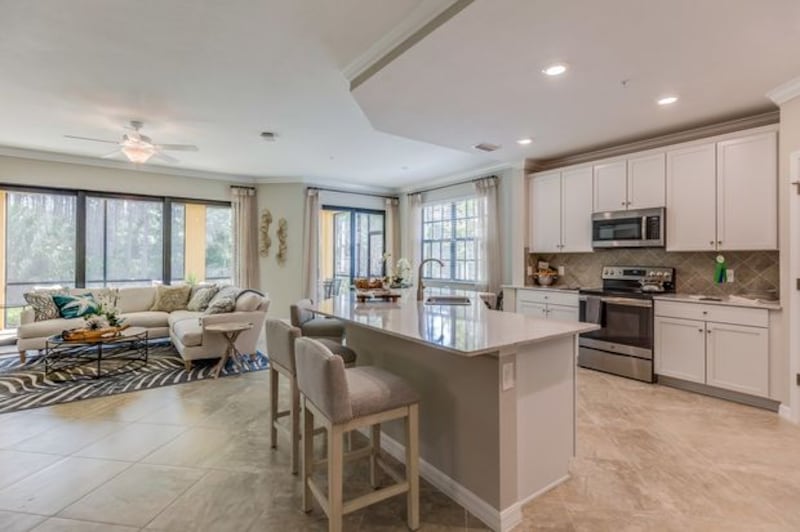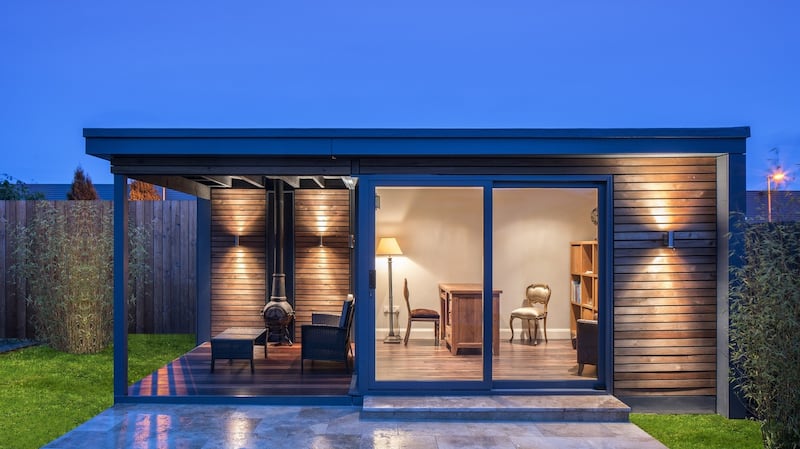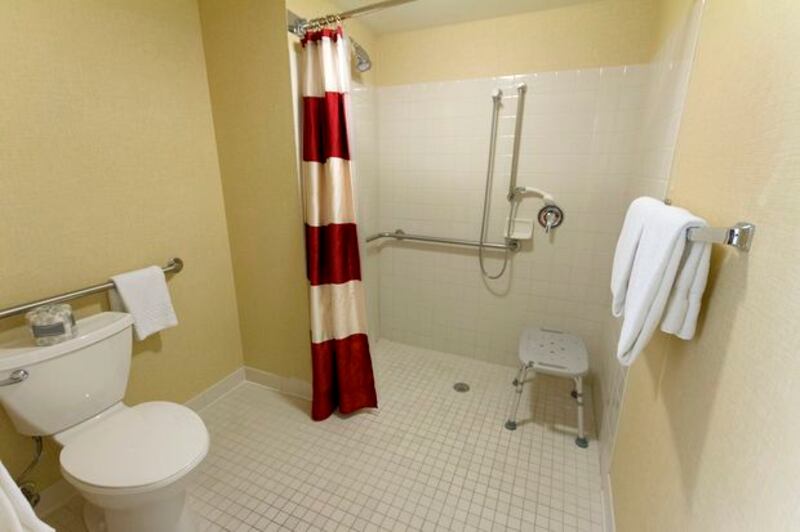A Zoom call in the box-room, a sales pitch in the attic, a college lecture in the kitchen – our homes have never worked so hard. Our place to sleep, eat and relax is now an office, school and university too. The pandemic won’t be with us forever, so rejigging space for lockdown living isn’t the answer. With the crisis shaking up norms and accelerating trends, how can we future-proof our homes, and how much will it cost?
Working from home is a new normal that's becoming just normal. Some 94 per cent of people want to work remotely some or all the time post-pandemic, an NUI Galway survey has found. Employers will have to take heed to retain talent. Some college students have always lived at home, but this year, 60 per cent are doing so, according to Zurich. Parents weighing up paying €1,000 a month for a child to live away may well balk.
Even before the pandemic, some 47 per cent of Irish adults aged 25-29 lived with their parents, according to EU agency Eurofound. Housing costs here were adding to later household formation, but a Covid-19 flight from shared rental accommodation has seen more people move home. Pandemic layoffs and the option to work remotely are adding to the numbers who boomerang home.
The virus has also highlighted deficits in elder care. Nursing homes were among the hardest hit. With more of us now living longer, healthier lives anyway, specifically adapting our homes to live there for longer, or to accommodate an ageing parent to live with us, will be a priority. So if you had planned to invest in your house, these are some of the trends that should influence your spend, long after the pandemic is over.
Extending

An extension to the rear is a usual way to add more space, but putting your separate office there messes with direct access to the garden that is valuable in a kitchen-dining-living area. "You might be better rethinking the interior layout of the house to see where is best to locate this self-contained area to act as a study or a separate space," says architect Fionnuala Rogerson.
An open-plan kitchen-living-dining area to the rear is how the vast majority of new homes are designed and how many existing houses are extended. While lockdown living has made us yearn for separated space, extending, but with a “broken plan” scheme, can achieve this. Kitchen-living-dining extensions are big business; shelving, an island or a small wall can all provide separation.
A single-height extension to create an open-plan living space is the most common request from three-bed semi homeowners, says Cork-based quantity surveyor Karl Slyne. By keeping the extension to 40sq m, planning permission is not required, speeding things up. For a "full package" – including the kitchen, painting, tiling and finishes – homeowners should budget for €1,800 per sq m (ex VAT) "for a really basic" scheme, says Slyne.
A pricey kitchen, nice rooflights, lots of glass and a wide sliding door at the back will see costs climb to €2,500 per sq m, or about €100,000. Adding underfloor heating to a small extension will add about €8,000.
Attic conversion

With adult family members now under one roof for longer, there can be greater need for separate space. Once their social lives resume post-Covid, adult children will scarper again, returning home to sleep and eat. Some living at home, however, will continue to work from home.
An attic conversion provides extra space but within the existing house footprint, and so will be cheaper than an extension. An attic room can be a home office somewhat separated from family life, or, if compliant with onerous fire regulations, an ensuite bedroom. A basic conversion with stairs, electrics, plumbing, insulation and plasterboard will set you back about €15,000, says Slyne. Add another €5,000 for a bathroom. To create a compliant bedroom with a rejig for headroom and some rooflights, expect to pay €30,000 and upwards.
According to Slyne, specialist attic conversion companies can be faster and more cost-effective than a builder. Engage an engineer or architect to ensure compliance, as not having the right certification will affect the saleability of your home.
Not all attics are readily converted and this is something developers and architects need to consider, says Rogerson. “If we are putting pitched roofs on houses, let’s put them steep enough that they can be converted. Let’s plan the interior so that the circulation space readily takes a staircase going up to attic. Let’s consider it at the beginning by putting in joists that are suitable for conversion.”
Room outside

If you need a quick solution, a garden room is one answer. You can’t live in one, but add a Cat 6 cable, a swivel chair and a stress ball and you’ve got yourself a home office.
“Houses aren’t getting any bigger, but families need more space,” says Martin McGuire of Rooms Outside. His family is experiencing the squeeze first-hand. “My daughter is in our attic doing a degree in aviation technology right now; we are lucky the house is big enough that she can do that.”
Even before the pandemic, some 70 per cent of his clients were after a home office. “There was a gravitation towards this anyway – the pandemic has just accelerated it,” he says. Prices for the timber structure begin at €15,200 for the smallest 12sq m size, with electricity and broadband cabling extra depending on their length.
You don’t need planning permission for a garden room, but you can’t live in one. They can’t go in the front garden and their installation must mean at least 25sq m of garden space remains. Even in tight terraces, the materials can be brought through the front door, says McGuire. His garden rooms take two to four weeks to install, but, he adds, such is demand that the soonest you’ll get one now is April 2021.
If you anticipate home working post-pandemic, having a separated space to do so could save your sanity, says Frank O’Sullivan of Shomera. He says the “12-step commute” from home to garden room is vital for the long-term sustainability of home working. “People are really struggling with everything being under one roof. Young kids don’t understand that Mom or Dad can be at home but at work.”
Add a Leaving Cert student who will live at home through college and the case for a separate space mounts. Throw in a TV, an Xbox and some beanbags, and it becomes a rec space for a teenager or adult child needing a break from family life.
Rent a room scheme
With any luck, children will eventually fly the nest. A house once bursting at the seams may then exceed your needs. With the right tenant, the Government’s Rent-a-Room scheme can be a good way to monetise an empty bedroom, and provide company if that’s what you want.
Householders can earn up to €14,000 a year tax-free from renting a room in the house they occupy. Renting a room that is part of your home is not subject to landlord and tenant law, meaning more flexibility on notice periods should your circumstances change.
Good planning can make sure a future tenant doesn’t cramp your style. “Often when we are converting garages, we will put an access from the hall into the garage, so if you are renting a room to a student, they can come in the front door and get to their room without having to go into the kitchen or disrupt family life,” says O’Sullivan. “It also means they are not upstairs where the family has its bedrooms.”
A granny flat, perhaps with a bedroom, bathroom and kitchenette, is a self-contained unit attached as an extension to the main house. It’s not just for Granny; another family member like an adult child saving for a house deposit could live there too.
In general, planning permission is not required if the extension does not increase the original floor area of the house by more than 40sq m. Expect to spend €50,000-€55,000 for this kind of extension, says Slyne. Regulations on granny flats differ between local authorities, so consult with a planning expert before construction.
Design for life

Repeated studies show that as we age, we want to continue living in our communities. With the right planning, we can future-proof our houses to do so comfortably.

Rogerson is currently finishing off an extension for an older couple that are installing an accessible shower room downstairs as well as allowing for a potential future bedroom there. (An accessible downstairs shower room will cost up to €10,000, says Slyne).
“It takes a lot of work to figure out what will work best at all stages of your life,” says Rogerson. “It needs people working with architects saying that they want to plan for the future, and that they want the space to be as flexible as possible. A good architect will come up with a solution for that. You may have to give up a little bit of what you want right now in order to future-proof for down the road.”
Finance
If you want to future-proof your house, how can you pay for it? If you don’t have savings, you may be able to borrow. The amount of your outstanding mortgage and the value of your home will determine how much.
"If you have a loan-to-value ratio of 50 per cent and you want to borrow €100,000 or €150,000, once the equity is there the bank should have no problem supporting the application," says Michael Dowling of Dowling Financial. "You'll have two mortgages: your existing one paid as usual and then a top-up mortgage, which might be shorter-term if you decide to do that."
The new top-up mortgage will be at current rates. He says Irish banks will lend with a repayment term to between the ages of 67 and 70. If your borrowings increase your loan-to-value ratio significantly, it may be treated as a new mortgage application, with the usual salary certificates and bank statements required to prove your repayment capacity.
For a significant top-up mortgage, or where planning permission is required, the bank may release funds in stages, giving the last part when works are finished. You’ll need to agree this with your builder at the outset.
A mortgage application takes time, so if works are less significant, a personal loan or a credit union home renovation loan can make more sense. A mortgage entails getting your home valued and engaging a solicitor, so spending over €1,000 on that to borrow €15,000 won’t make sense, says Dowling. Mortgage borrowings will be cheaper than personal borrowings, however.












